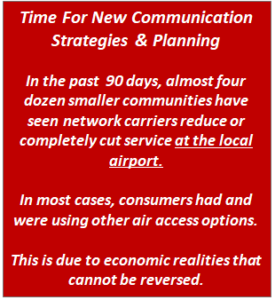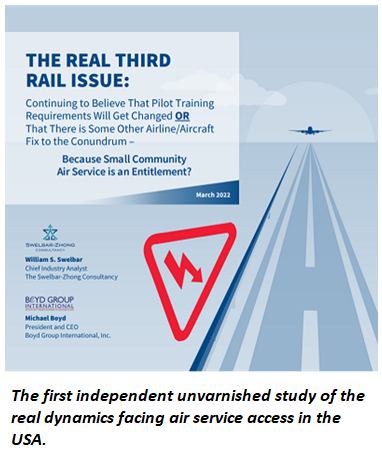Small Community Air Service Access Loss:
The “Pilot Shortage” Is Just The Messenger
Last week SkyWest – operating as United Express – announced it wanted out of Essential Air Service contracts at 29 airports.
That’s 29 small community local airports. The DOT will be soliciting air operators to replace United Express flights.
 The only fly in the EAS ointment is that there will be no replacements. There may be some fine operators tapped to replace SkyWest, but they won’t replace the air service that was provided by United Express.
The only fly in the EAS ointment is that there will be no replacements. There may be some fine operators tapped to replace SkyWest, but they won’t replace the air service that was provided by United Express.
It’s not just an announcement. It’s yet another indication that regionalization of air access is akin to gravity… it can only be delayed so long.
Consumers in any case won’t use air service that doesn’t at least deliver true connectivity to the rest of the nation. SkyWest/UAX did that. Unfortunately, in the majority of these deleted markets, even that didn’t deliver consumer-competitive air service. The load factor performance is clear proof.
Now, the fact is that there are no other operators that can replace what UAX offered. American is out – it’s cutting small community routes as we speak. Ditto Delta.
Let The ASD Rituals Begin. So, despite lots of civic hubris, and the indignant local congress reps jumping in their water dishes, plus the usual-suspect consultants closing in with crocodile-tear proposals for more studies and more meetings and more surveys, the truth is that there are no entities that can deliver what the United Express service did.
So, we’ll start with this blunt bit of truth… it is very unlikely that most of these airports will see replacement service anywhere near the quality and connectivity of what SkyWest/UAX offered. From the service perspective, it is mostly downhill from here… at the local airport, that is. Not necessarily for the local consumer, who at many of these affected communities has been using other air access options, anyway.
This is an opportunity for these communities to re-think the future, instead of being misled into the fantasy that air service consumers won’t use should be the new goal.
 Blame The Pilot Shortage – But It’s “The Why” This Was A “Shortage” Target. As with just about everything else unpleasant that takes place in aviation today, it’s all the fault of the pilot shortage. See, according to the Regional Airline Association and others, if we had more pilots, these service deletions would not have taken place.
Blame The Pilot Shortage – But It’s “The Why” This Was A “Shortage” Target. As with just about everything else unpleasant that takes place in aviation today, it’s all the fault of the pilot shortage. See, according to the Regional Airline Association and others, if we had more pilots, these service deletions would not have taken place.
That is sheer misleading nonsense. Let’s remember that these EAS markets are cost-plus for the operator. But in a shortage, the highest and best use of resources is the #1 consideration in business planning. That’s where EAS flight applications got into the red-pencil crosshairs… those scarce pilot resources were flying a whole lot of sailboat fuel, instead of passengers. So, even if there were pilots banging on the airline’s door, it doesn’t change the fact that much of this EAS flying is a national waste embarrassment.
Trying To Fix A Laptop Computer With A Vacuum Tube. Amid the gnashing of teeth at various city halls, not to mention some congress people running around denouncing SkyWest’s decision, there are some hard facts that illuminate not only SkyWest’s decision, but the need to address the entire approach to small community air service, including EAS and the Small Community Air Service Development grant program.
These government schemes are vainly trying to engender an air transportation system that’s based on obsolete assumptions, lack of understanding of the shifts in air service as a communication channel, and on near-zero recognition of consumer trends. Should be embarrassing to the DOT.
The Message Is Clear – But Will The DOT Get It? A couple of raw statistics… of the 29 markets cut…
21 had less than a 40% load factor for the full-year ending 11/21
Of those, ten were under 30% load factors… a few, well under.
Several of these EAS points are within an hour of another, better-served airport.
Poster children for the latter waste point are Pueblo and Muskegon. Both have access within an hour or less of alternative gateways with dozens of flights, including service via Southwest, all of which make the local EAS flights non-competitive. Except to politicians, there is no viability for such flights.
The Chosen Replacements Won’t Replace… Let’s go back 23 years. At the Boyd Group International Aviation Summit, we pointed out that the only way that EAS service had even a snowball’s chance in Miami of being consumer-viable, it had to have the following characteristics.
A minimum of two departures per day…
With service to a major airline’s connecting hub-site…
On flights clearly branded as those of the hub-site carrier’s system.
As it turns out, all three of these criteria were in place at each of the 29 EAS markets that were dropped. All were to at least one United hubsite. All were branded as United Express, delivering the connectivity of the UAL system. Plus, the service had the enormous service factors attendant to United – the Mileage Plus frequent flyer program, and exposure in CRS systems across the world, among others.
It can’t get any better.
Yet, it still didn’t work… proven by the load factors attained. It’s a market realities issue. No wonder the decision was made that pilot resources could be used more productively elsewhere. So, the fact remains that even if pilots were available, it would be a colossal waste of these skills flying near-empty airplanes that consumers won’t use.
A Message To Move On, Not Backward. Already there are the expected declarations from some communities that “we’ll find another airline!”
To speak the truth, in most cases, functionally and service-qualitatively, no you won’t. There will not be a replacement that will provide the connectivity and the service features that was experienced with SkyWest/UAX.
Optimizing The Situation. While this won’t set well with some airports and communities, it remains the truth: the EAS program, as currently structured is a giant mess. As the CEO of United has stated, that money could be used better to train pilots… or other things. BGI and Swelbar-Zhong have urged that the SCASD program be shifted into one that supports economic growth initiatives at small airports, instead of embarrassing goals such as alleviating “higher than average airfares” – a metric that is beyond dimbulb and simply non-existent.
The SkyWest/UAX EAS decision comes on the heels of another – at least – 21 short haul hub feed routes given the pink slip by United and American in the last three months. Get the trend here?
 What else is needed to see what’s coming? It sure isn’t another leakage study to find “more airlines.” In this case, it’s not a simple matter of hiring more pilots. It’s about the need to re-think air service realities and air service capabilities.
What else is needed to see what’s coming? It sure isn’t another leakage study to find “more airlines.” In this case, it’s not a simple matter of hiring more pilots. It’s about the need to re-think air service realities and air service capabilities.
Get Some Future Perspectives. If you haven’t reviewed it, BGI and Swelbar-Zhong have published an independent study of the small community air service realities. Click here to download your copy.
It’s a must for not just airports and communities, but for engineering firms and financial institutions, too. We don’t sugar coat anything, and we outline alternative paths to assuring communicative connectivity for small communities.
There are options for the future of rural air service access, but today, it has degenerated into simply paying lots of tax dollars to have just flights at the local airport, instead of developing new-concept connectivity approaches.
In this study, we’re not necessarily promulgating anything… just illuminating hard economic realities that today are too often smoke screened by eager “studies” or “civic meetings” or other expensive diversions.
Looking For Solutions & Futurist Assistance? And, if you’re interested in fresh, data-driven forecasts of emerging trends and new airport planning strategies, drop us an email – both BGI and Swelbar-Zhong are ready to deliver. We don’t run with the pack… we are well ahead of it.
And so are our clients.